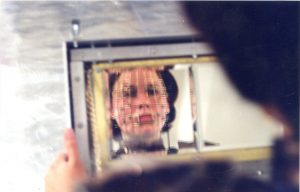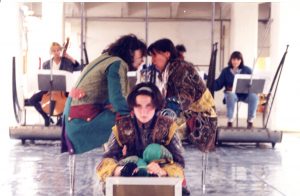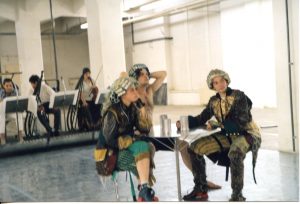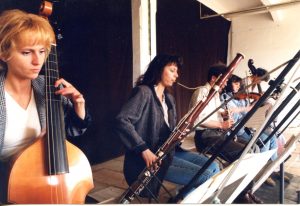NOAH TRILOGY is an intimate, personal performance-event with dance, theatre, livemusic, video, computer animation, space installation and computer generated sound installation with the participation of the fine artist and also exhibition opening and party. As the audience stream into the auditorium to take a seat, their faces are filmed, their names are written down and their voices are recorded. In the course of the performance these recorded features will appear on stage, mingled and rejigged in a computer portrait. The trilogy offers the audience a three and a half hour long journey through 3 acts:
I. – PORTRAIT C
“I came into conflict with God. He lost.
I stood him into the stocksand
I expelled him from the Garden ,
Many things happened after this…
I do not remember. “
Each performance has a different visual artist as participator. First he/she breaks his/her own reflection in the mirror and then he/she recreated a new unique image (a portrait) by following what unfolds in front of him/her on the stage. The performance is the model of the running „portrait”: music, dance, texts and mosaics of other undefinable phenomena. In the intervals between the surrealistic dance and theatre scenes the spectators can follow the progress of the work of both artists displayed on a large screen at centre back. Finally the audience is invited on stage to have a closer look on the exhibited art works created during the current and previous performances of Portrait C. During the one hundred performances of PORTRAIT C, meaning „100 portraits”, 100 glass portraits and 100 computer animated portraits are created.
II. – STAR GRINDER
Still on stage watching the exhibition of Portrait C, the spectators surprisingly hear their own recorded voices, while musicians escort them forward to enter a total dark space. At the entrance each person receives a torch which enables them to move free and focus individually by light on the scenery and acts in the darkness.
“You who enters here… watch your head!”
Leaving the dark space of Star-Grinder the audience is invited for a party, but still new acts take place in the nearby stage-area: simple black and white, soundless movements, symbols, figures, characters. There are the party and the performance. Two different worlds existing parallel each other. The spectators need to choose.
III. – Motionless trip aka Chinvat – the ninth bridge
It is told that once upon a time there used to be nine bridges, through which humans could reach the land where they could live in peace with the conscience. But humans live and die, they fail and recover, destroy and build. T hey speak an awful lot, yet they cannot say what they think. They lie a lot, the most to themselves. Sometimes they get enlightened, but the next d ay they will turn away from themselves. Thus, 8 bridges have already been demolished. The ninth bridge is the Chinvat. Those who step on it, say no more words. Humans are measured not through their words but their deeds.
Reviews in English & Hungarian language:
Wei-Yun Lin: In the Name of Dance, Artus’s séance NoahTrilogy
Gondolatokat ébreszteni – Sándor L. István interjúja Goda Gáborral – 1999
Kivonulás a színházból? – Sándor L. István két műhelybeszélgetés Goda Gáborral – 1997
Kaposi Viktória: „Vagyok, aki vagyok. Az vagyok, aki itt áll szemben.”
Lőrinc Katalin: Barokk töredékek – Artus: Portré C. / 6
Where & when…
Cast:
| Writer-director: | GODA Gábor |
| Coreographer | GODA Gábor, MÁNDY Ildikó, PINTÉR Béla, REGENHART Éva |
| Composer: | STOLLÁR Xénia |
| Architect: | SEBESTYÉN Ferenc |
| Costume designer: | SZŰCS Edit |
| Sound engineer: | HORVÁTH István |
| Installation: | BERECZKY Péter, KERESZTES Zsuzsa, KOCSIS Gábor, OLDAL István, SÓLYOM Tamás, ERNST Süss, BABAY Zsolt |
| Video: | ERNST Süss |
| White shadow: | NÁDOR Tibor |
| Computer technology: | NYITRAY Orsolya, LANGH Róbert |
| Light designer: | KOCSIS Gábor |
| Performers: | GODA Gábor, MÁNDY Ildikó, REGENHART Éva, PINTÉR Béla, GOLD Bea, NAGY Andrea, KOCSIS Gábor, ERNST Süss STOLLÁR Xénia – viola da gamba SOMOGYI Erzsébet – bassoon ROZMÁN Lajos – clarinet WINKLER Orsolya – violin CZIBERE József – percussion NYITRAI Orsolya – computer |







